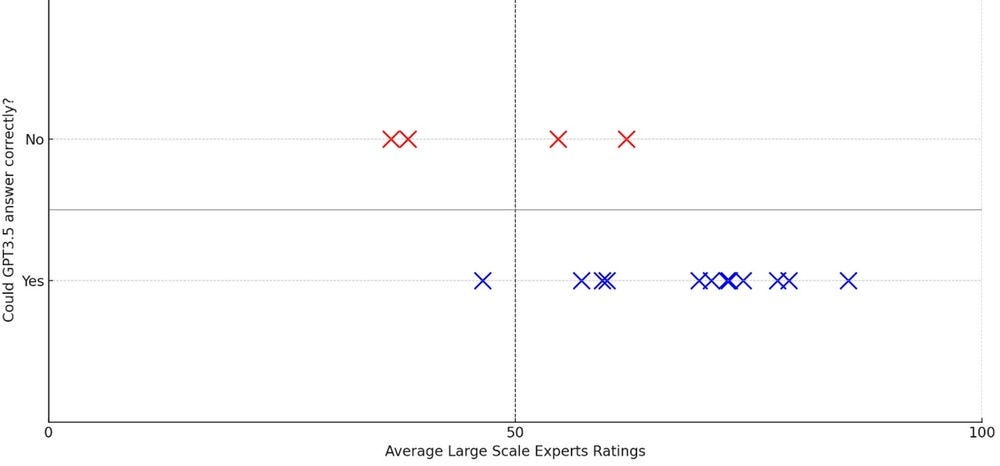[15] Bolger, G. (ed.) (1992), Perspectives on Expertise in the Aggregation of Judgments, Plenum.
[7] Bubeck, S. et al. (2023), “Sparks of Artificial General Intelligence: Early experiments with GPT-4”.
[9] Clark, P. and O. Etzioni (2016), “My Computer Is an Honor Student — but How Intelligent Is It? Standardized Tests as a Measure of AI”, AI Magazine, Vol. 37/1, pp. 5-12, https://doi.org/10.1609/aimag.v37i1.2636.
[24] Drori, I. et al. (2021), “A Neural Network Solves, Explains, and Generates University Math Problems by Program Synthesis and Few-Shot Learning at Human Level”, https://doi.org/10.1073/pnas.2123433119.
[2] Elliott, S. (2017), Computers and the Future of Skill Demand, Educational Research and Innovation, OECD Publishing, Paris, https://doi.org/10.1787/9789264284395-en.
[8] Frieder, S. et al. (2023), “Mathematical Capabilities of ChatGPT”.
[5] Hendrycks, D. et al. (2020), “Measuring Massive Multitask Language Understanding”.
[22] Hendrycks, D. et al. (2021), “Measuring Mathematical Problem Solving With the MATH Dataset”.
[23] Lewkowycz, A. et al. (2022), “Solving Quantitative Reasoning Problems with Language Models”.
[3] OECD (2023), Is Education Losing the Race with Technology?: AI’s Progress in Maths and Reading, Educational Research and Innovation, OECD Publishing, Paris, https://doi.org/10.1787/73105f99-en.
[18] OECD (2023), Putting AI to the test: How does the performance of GPT and 15-year-old students in PISA compare?, OECD Education Spotlights, No. 6, OECD Publishing, Paris, https://doi.org/10.1787/2c297e0b-en.
[4] OECD (2019), PISA 2018 Results (Volume I): What Students Know and Can Do, PISA, OECD Publishing, Paris, https://doi.org/10.1787/5f07c754-en.
[1] OECD (2019), Skills Matter: Additional Results from the Survey of Adult Skills, OECD Skills Studies, OECD Publishing, Paris, https://doi.org/10.1787/1f029d8f-en.
[13] OECD (2016), PISA 2015 Results (Volume I): Excellence and Equity in Education, PISA, OECD Publishing, Paris, https://doi.org/10.1787/9789264266490-en.
[21] OECD (2016), “PISA 2015 test items”, in PISA 2015 Results (Volume I): Excellence and Equity in Education, OECD Publishing, Paris, https://doi.org/10.1787/9789264266490-15-en.
[11] OECD (2013), The Survey of Adult Skills: Reader’s Companion, OECD Publishing, Paris, https://doi.org/10.1787/9789264204027-en.
[10] OECD (2012), Literacy, Numeracy and Problem Solving in Technology-Rich Environments: Framework for the OECD Survey of Adult Skills, OECD Publishing, Paris, https://doi.org/10.1787/9789264128859-en.
[12] OECD (2009), Take the Test: Sample Questions from OECD’s PISA Assessments, PISA, OECD Publishing, Paris, https://doi.org/10.1787/9789264050815-en.
[14] OECD (2007), PISA 2006: Science Competencies for Tomorrow’s World: Volume 1: Analysis, PISA, OECD Publishing, Paris, https://doi.org/10.1787/9789264040014-en.
[6] OpenAI (2023), GPT-4 Technical Report, https://cdn.openai.com/papers/gpt-4.pdf.
[17] Radford, A. et al. (2018), Improving Language Understanding by Generative Pre-Training, https://s3-us-west-2.amazonaws.com/openai-assets/research-covers/language-unsupervised/language_understanding_paper.pdf (accessed on 1 February 2023).
[20] Rajpurkar, P., R. Jia and P. Liang (2018), “Know What You Don’t Know: Unanswerable Questions for SQuAD”.
[16] Tversky, A. and D. Kahneman (1974), “Judgment under Uncertainty: Heuristics and Biases”, Science, Vol. 185/4157, pp. 1124-1131, https://doi.org/10.1126/science.185.4157.1124.
[19] Ye, J. et al. (2023), “A Comprehensive Capability Analysis of GPT-3 and GPT-3.5 Series Models”.









